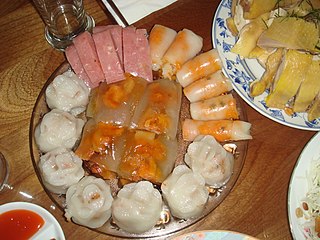
A sausage is a type of meat product usually made from ground meat—often pork, beef, or poultry—along with salt, spices and other flavourings. Other ingredients, such as grains or breadcrumbs, may be included as fillers or extenders.

Pigs in a blanket in the United States is a small hot dog or other sausage wrapped in pastry similar to a sausage roll in the UK, it is commonly served as an appetizer in the United States. The similarity in name with that of the UK dish pigs in blankets, which is a sausage wrapped in bacon, sometimes causes confusion.

Ukrainian cuisine is the collection of the various cooking traditions of the people of Ukraine, one of the largest and most populous European countries. It is heavily influenced by the rich dark soil (chornozem) from which its ingredients come, and often involves many components. Traditional Ukrainian dishes often experience a complex heating process – "at first they are fried or boiled, and then stewed or baked. This is the most distinctive feature of Ukrainian cuisine".
Romanian cuisine is a diverse blend of different dishes from several traditions with which it has come into contact, but it also maintains its own character. It has been mainly influenced by Turkish but also a series of European cuisines in particular from the Balkan Peninsula and Hungarian cuisine as well as culinary elements stemming from the cuisines of Central Europe.

Comfort food is food that provides a nostalgic or sentimental value to someone and may be characterized by its high caloric nature associated with childhood or home cooking. The nostalgia may be specific to an individual or it may apply to a specific culture.

Beef Wellington is a steak dish of English origin, made out of fillet steak coated with pâté and duxelles, wrapped in puff pastry, then baked. Some recipes include wrapping the coated meat in a crêpe or dry-cured ham to retain the moisture and prevent it from making the pastry soggy.

Czech cuisine has both influenced and been influenced by the cuisines of surrounding countries and nations. Many of the cakes and pastries that are popular in Central Europe originated within the Czech lands. Contemporary Czech cuisine is more meat-based than in previous periods; the current abundance of farmable meat has enriched its presence in regional cuisine. Traditionally, meat has been reserved for once-weekly consumption, typically on weekends.

Chinese Indonesian cuisine is characterized by the mixture of Chinese with local Indonesian style. Chinese Indonesians, mostly descendant of Han ethnic Hokkien and Hakka speakers, brought their legacy of Chinese cuisine, and modified some of the dishes with the addition of Indonesian ingredients, such as kecap manis, palm sugar, peanut sauce, chili, santan and local spices to form a hybrid Chinese-Indonesian cuisine. Some of the dishes and cakes share the same style as in Malaysia and Singapore, known as Nyonya cuisine by the Peranakan.

Gỏi cuốn, nem cuốn, salad roll, summer roll, fresh spring roll, or rice paper roll is a Vietnamese dish traditionally consisting of pork, prawn, vegetables, bún, and other ingredients wrapped in bánh tráng. Unlike other spring roll dishes, which are believed to originate from China, Vietnamese gỏi cuốn is a national creation using bánh tráng.

In Vietnamese, the term bánh translates loosely as "cake" or "bread", but refers to a wide variety of prepared foods that can easily be eaten by hands or chopsticks. With the addition of qualifying adjectives, bánh refers to a wide variety of sweet or savory, distinct cakes, buns, pastries, sandwiches, and other food items, which may be cooked by steaming, baking, frying, deep-frying, or boiling. Foods made from wheat flour or rice flour are generally called bánh, but the term may also refer to certain varieties of noodle and fish cake dishes, such as bánh canh and bánh hỏi.

Regional street food is street food that has commonalities within a region or culture.

This is a list of prepared-foods list articles on Wikipedia.

Embutido, or embotido, is a Philippine meatloaf made with ground pork and stuffed with hard-boiled eggs and sliced ham or various sausages. It is traditionally wrapped in aluminum foil and steamed, though it can also be baked.

A meat-free sausage roll is a savoury pastry snack that contains a non-meat filling. The snack is an alternative to the conventional sausage roll that generally contains pork or beef. Meat-free sausage rolls are sold at retail outlets and are also available from bakeries as a take-away food.

















